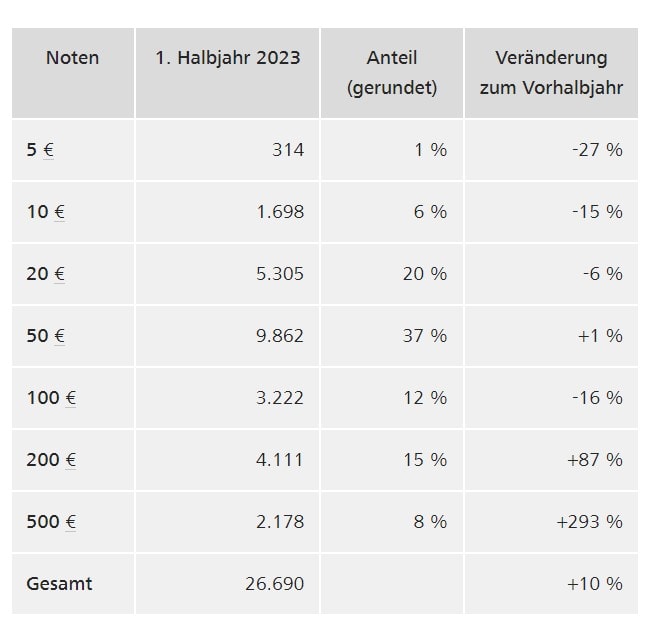More counterfeit 200 and 500 euro banknotes
In the first half of 2023, the German Bundesbank withdrew a total of 26,700 euro banknotes from circulation. The number of counterfeit 200- and 500-euro banknotes in particular has increased.

The number of counterfeits has increased by 10 percent compared to the second half of 2022, the German Bundesbank said. According to the data, around 26,700 counterfeit euro banknotes with a face value of just under 2.9 million euros were withdrawn from circulation in the first six months of this year. Nevertheless, the volume of counterfeit money remains low: in purely arithmetical terms, six counterfeit banknotes were produced for every 10,000 inhabitants.
said Burkhard Balz of the Deutsche Bundesbank.
Fraudulent business
In particular, the number of counterfeit 200- and 500-euro banknotes increased, the statement said. As a result, the amount of losses in the first half of 2023 was 66 percent higher than in the previous six months, it said. "The counterfeit 200- and 500-euro banknotes were mainly used to conduct fraudulent transactions involving luxury goods such as jewelry, gold bars, watches and cars," Balz said.
The proportion of simple counterfeits with "MovieMoney" printed on the front and "Prop copy" printed on the back remained high. In some of these counterfeits, the counterfeiters had covered up the imprint "MovieMoney" and replaced it with the imitation of a signature.
Also more fake coins
While around 40,800 counterfeit coins were detected in German payment transactions in the second half of 2022, the figure was around 49,000 pieces in the first half of 2023. According to the data, there were arithmetically around twelve counterfeit coins per 10,000 inhabitants and year in Germany in the first half of 2023. The significant increase (+21 percent) is due to the fact that credit institutions and cash-in-transit companies are still processing backlogs of coins from the Corona pandemic that are no longer fit for circulation. These also included counterfeit coins, according to the report.
The counterfeits occurred exclusively in the three highest denominations and were distributed as follows in the first half of 2023:

Source: Deutsche Bundesbank
Detect counterfeit banknotes
Since counterfeit money is not replaced, banknotes should be checked according to the "feel-see-tilt" principle, writes the Deutsche Bundesbank. It is advisable to compare a suspicious banknote with one that is undoubtedly genuine and to always look at several security features.
All counterfeits can be identified by the following authenticity features:
- Feel:
- With most euro banknotes, the banknote paper feels grippy and firm. This means that simple counterfeits can be detected just by touching them. To be on the safe side, however, the Bundesbank recommends checking other features.
In the euro series, the €5, €10 and some of the €20 banknotes have been coated and therefore feel smooth and solid. Of the 20-euro banknotes, both lacquered and unlacquered pieces occur in payment transactions.- On the front sides of the banknotes, highlighted parts of the printed image can be felt in relief. On the left edge, for example, there is the lettering "BCE ECB EЦБ EZB EKP EKT EKB BĊE EBC" in the Europa series (as well as "ESB" from the €50 banknote) and additional hatching on the right and left edges.
- See:
- The watermark can be seen in the unprinted area of each banknote as a shadow image when held up to the light.
- In the upper area of the hologram strip, there is a transparent window on the Europa series from the €20 banknote onward. It shows a portrait of Europa, a figure from Greek mythology.
- Tilting:
- The hologram elements change when the banknote is tilted. Rainbow-colored effects surround the motifs.
- The banknotes in the Europa series also feature the emerald numeral on the lower left-hand side of the front: When tilted, its color changes and a light bar moves up or down.
- The 100 and 200 euro banknotes have additional security features: In the emerald number, there are several euro symbols that change color. The satellite feature can be found in the hologram. Here, two euro symbols circle around the value numeral.
Source: Deutsche Bundesbank









